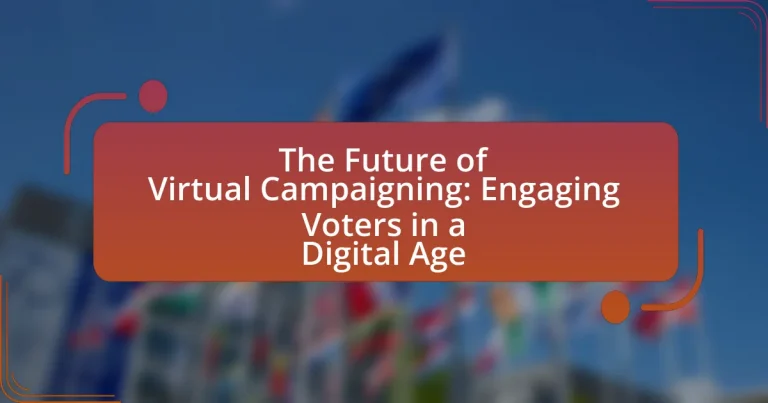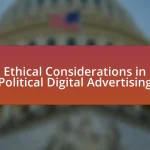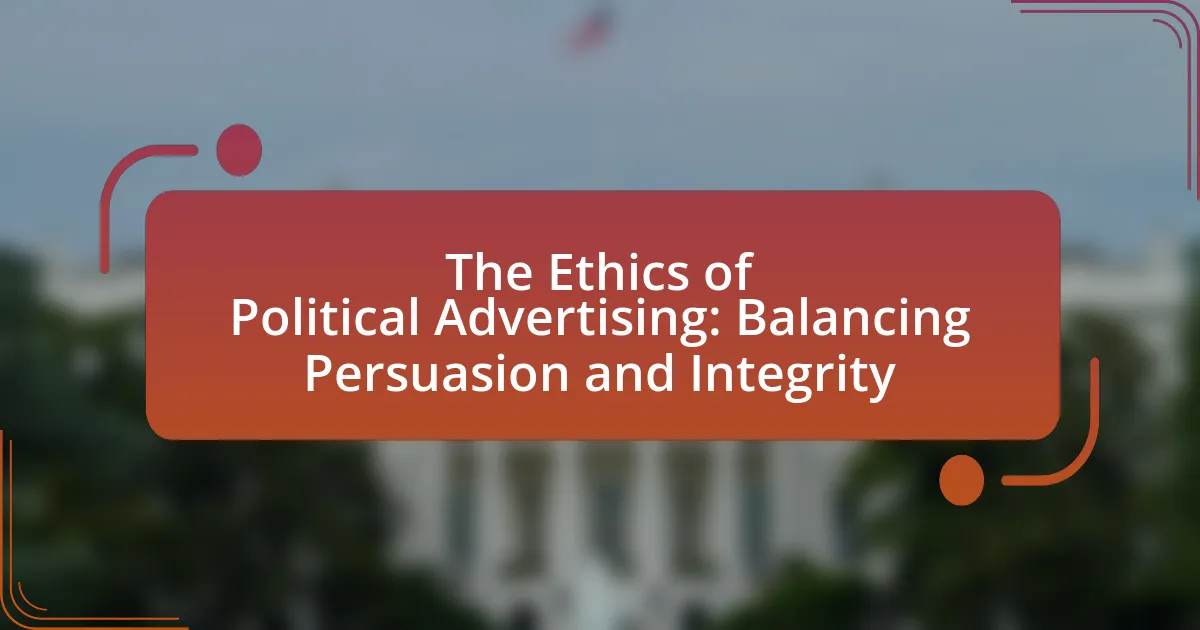The article focuses on the future of virtual campaigning, emphasizing the integration of advanced technologies such as artificial intelligence, augmented reality, and data analytics to enhance voter engagement. It explores how virtual campaigning is evolving in the digital age, highlighting the significance of social media platforms for targeted communication and real-time voter interaction. Key strategies for effective virtual campaigning, including data-driven outreach and compelling content creation, are discussed, along with the challenges posed by misinformation and the importance of ethical practices in maintaining voter trust. The article underscores the impact of virtual campaigning on voter turnout and participation, providing insights into best practices for leveraging digital tools to connect with the electorate.

What is the Future of Virtual Campaigning?
The future of virtual campaigning is characterized by increased integration of advanced technologies such as artificial intelligence, augmented reality, and data analytics to enhance voter engagement and outreach. As digital platforms continue to evolve, campaigns will leverage these technologies to create personalized experiences, optimize targeting, and analyze voter behavior more effectively. For instance, a report by the Pew Research Center indicates that 53% of voters prefer receiving campaign information through social media, highlighting the importance of digital channels in future strategies. Additionally, the rise of virtual reality experiences in campaigning can provide immersive ways for candidates to connect with voters, making the campaign process more interactive and engaging.
How is virtual campaigning evolving in the digital age?
Virtual campaigning is evolving in the digital age through the integration of advanced technologies and data analytics to enhance voter engagement. Campaigns now utilize social media platforms, targeted advertising, and real-time data to tailor messages to specific demographics, increasing the effectiveness of outreach efforts. For instance, a study by the Pew Research Center found that 69% of adults in the U.S. use social media, making it a crucial channel for political communication. Additionally, the use of artificial intelligence and machine learning allows campaigns to analyze voter behavior and preferences, enabling more personalized interactions. This evolution reflects a shift towards a more data-driven approach in political campaigning, enhancing the ability to mobilize and engage voters effectively.
What technological advancements are shaping virtual campaigning?
Technological advancements shaping virtual campaigning include artificial intelligence, social media analytics, and virtual reality. Artificial intelligence enables targeted advertising and voter engagement through personalized content, enhancing campaign effectiveness. Social media analytics provide insights into voter behavior and preferences, allowing campaigns to tailor their strategies accordingly. Virtual reality offers immersive experiences that can engage voters in unique ways, such as virtual town halls or interactive campaign events. These technologies collectively enhance the ability of campaigns to connect with voters in a digital landscape, as evidenced by the increased use of data-driven strategies in recent elections.
How do social media platforms influence virtual campaigning strategies?
Social media platforms significantly influence virtual campaigning strategies by enabling targeted communication and real-time engagement with voters. These platforms allow campaigns to analyze user data, facilitating personalized messaging that resonates with specific demographics. For instance, a study by the Pew Research Center found that 69% of adults in the U.S. use social media, making it a crucial channel for reaching a broad audience. Additionally, social media fosters interactive engagement, allowing campaigns to respond to voter concerns instantly, which enhances voter connection and mobilization. This dynamic interaction is supported by the fact that campaigns utilizing social media effectively can increase voter turnout by up to 10%, as reported in research by the Harvard Kennedy School.
Why is engaging voters through virtual campaigning important?
Engaging voters through virtual campaigning is important because it enhances accessibility and participation in the electoral process. Virtual campaigning allows candidates to reach a broader audience, including those who may be unable to attend traditional events due to geographical, physical, or time constraints. According to a study by the Pew Research Center, 53% of Americans reported that they prefer to receive political information online, highlighting the shift towards digital engagement. This method not only increases voter turnout but also fosters a more informed electorate by providing diverse platforms for discussion and interaction.
What impact does virtual campaigning have on voter turnout?
Virtual campaigning significantly increases voter turnout by enhancing accessibility and engagement. Studies indicate that digital outreach strategies, such as social media campaigns and online events, can reach a broader audience, particularly younger voters who are more likely to engage online. For instance, a 2020 study by the Pew Research Center found that 50% of young voters reported being influenced by social media campaigns, leading to higher participation rates in elections. Additionally, virtual campaigning allows for more personalized communication, which can motivate individuals to vote. This combination of increased reach and tailored messaging contributes to a measurable rise in voter turnout during elections.
How does virtual campaigning enhance voter engagement and participation?
Virtual campaigning enhances voter engagement and participation by utilizing digital platforms to reach a broader audience and facilitate interactive communication. This approach allows candidates to connect with voters through social media, webinars, and online events, making political discourse more accessible. For instance, a study by the Pew Research Center found that 69% of adults in the U.S. use social media, which candidates can leverage to disseminate information and mobilize supporters effectively. Additionally, virtual campaigning enables real-time feedback and engagement through polls and live Q&A sessions, fostering a sense of community and involvement among voters.
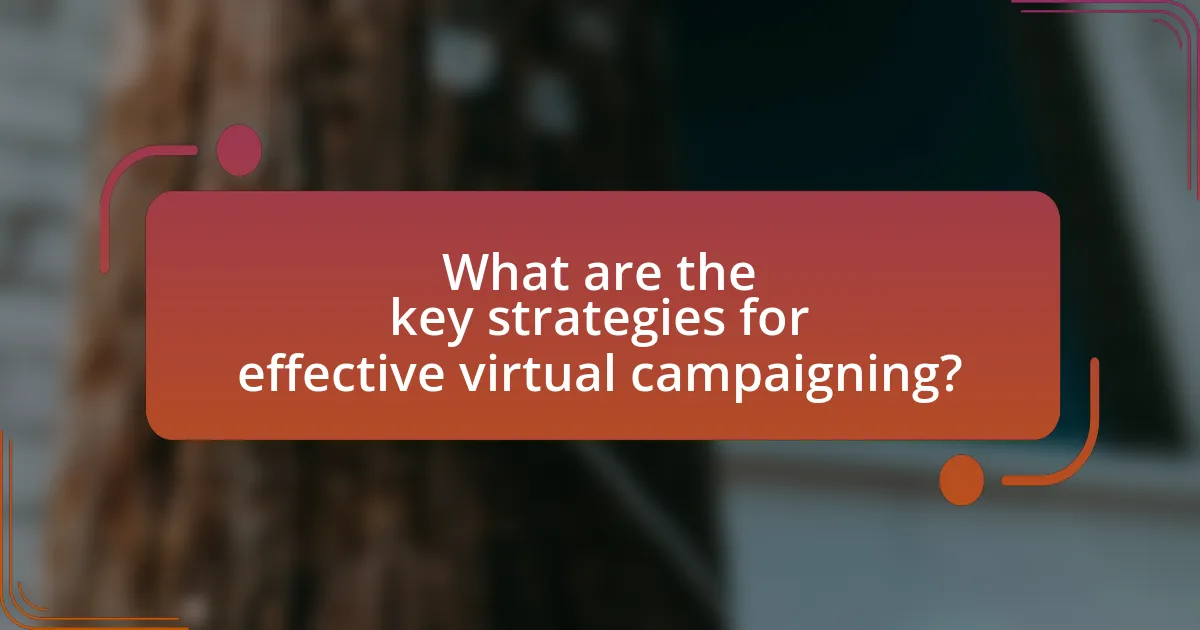
What are the key strategies for effective virtual campaigning?
Key strategies for effective virtual campaigning include leveraging social media platforms, utilizing targeted advertising, and engaging in data-driven outreach. Social media platforms like Facebook, Twitter, and Instagram allow campaigns to reach a broad audience and foster community engagement. Targeted advertising enables campaigns to focus on specific demographics, increasing the likelihood of voter engagement. Data-driven outreach, supported by analytics, helps campaigns understand voter preferences and tailor their messages accordingly. According to a study by the Pew Research Center, 69% of adults in the U.S. use social media, highlighting its importance in modern campaigning.
How can campaigns leverage data analytics in virtual campaigning?
Campaigns can leverage data analytics in virtual campaigning by utilizing insights from voter behavior and preferences to tailor their messaging and outreach strategies. By analyzing data from social media interactions, website traffic, and email engagement, campaigns can identify key demographics and adjust their content to resonate more effectively with target audiences. For instance, a study by the Pew Research Center found that 69% of adults in the U.S. use social media, highlighting the importance of these platforms for reaching voters. Additionally, campaigns can employ predictive analytics to forecast voter turnout and optimize resource allocation, ensuring that efforts are concentrated in areas with the highest potential impact. This data-driven approach not only enhances engagement but also increases the likelihood of mobilizing supporters effectively.
What types of data are most valuable for virtual campaign strategies?
The most valuable types of data for virtual campaign strategies include demographic data, behavioral data, engagement metrics, and sentiment analysis. Demographic data helps identify target audiences by age, gender, location, and interests, allowing campaigns to tailor messages effectively. Behavioral data tracks user interactions with campaign content, revealing preferences and engagement patterns. Engagement metrics, such as click-through rates and social media shares, provide insights into the effectiveness of campaign strategies. Sentiment analysis gauges public opinion and emotional responses to campaign messages, enabling adjustments to resonate better with voters. These data types collectively enhance the precision and impact of virtual campaigning efforts.
How can data analytics improve targeting and messaging?
Data analytics can significantly improve targeting and messaging by enabling campaigns to identify and understand voter preferences and behaviors. By analyzing data from various sources, such as social media interactions, survey responses, and demographic information, campaigns can segment their audience more effectively. For instance, a study by the Pew Research Center found that targeted messaging based on data analytics can increase engagement rates by up to 50%. This targeted approach allows campaigns to tailor their messages to resonate with specific voter groups, enhancing the relevance and impact of their communications.
What role does content play in virtual campaigning?
Content plays a crucial role in virtual campaigning by shaping voter perceptions and driving engagement. Effective content, such as videos, social media posts, and articles, communicates a candidate’s message, values, and policies, making it essential for building a connection with the electorate. According to a study by the Pew Research Center, 69% of adults in the U.S. use social media, highlighting the importance of tailored content that resonates with diverse audiences. Furthermore, engaging content can increase shareability, amplifying reach and influence, which is vital in a digital landscape where attention spans are short.
What types of content resonate most with voters in a digital environment?
Visual content, particularly videos and infographics, resonates most with voters in a digital environment. Research indicates that videos are shared 1,200% more than text and images combined, making them a powerful tool for engagement. Additionally, infographics simplify complex information, allowing voters to grasp key messages quickly. A study by the Pew Research Center found that 64% of voters prefer visual content over text, highlighting the effectiveness of these formats in capturing attention and conveying information.
How can storytelling enhance the effectiveness of virtual campaigns?
Storytelling enhances the effectiveness of virtual campaigns by creating emotional connections that resonate with audiences. This emotional engagement leads to increased retention of information, as narratives are more memorable than facts alone. Research indicates that stories activate brain regions associated with emotions and memory, making the content more relatable and impactful. For instance, a study published in the journal “Psychological Science” found that people are more likely to remember information presented in a narrative format compared to traditional presentations. By leveraging storytelling, virtual campaigns can foster a sense of community and motivate action, ultimately driving voter engagement in the digital age.
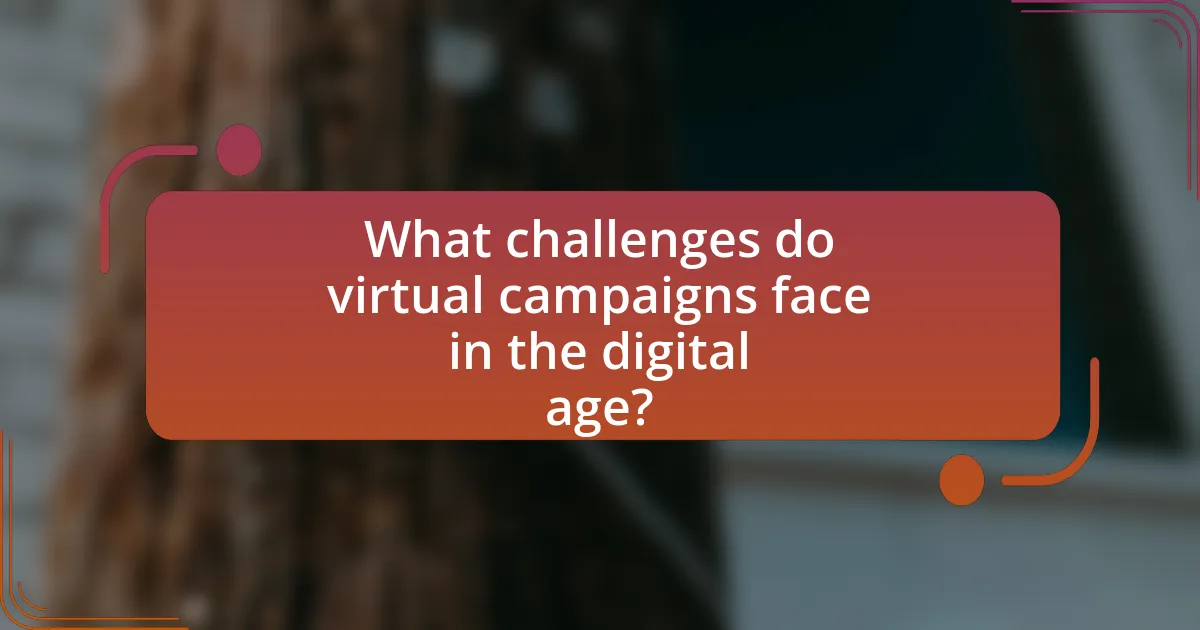
What challenges do virtual campaigns face in the digital age?
Virtual campaigns face several challenges in the digital age, including information overload, cybersecurity threats, and the need for authentic engagement. Information overload occurs as voters are bombarded with vast amounts of content, making it difficult for campaigns to capture attention effectively. Cybersecurity threats pose risks to data integrity and voter trust, as campaigns must protect sensitive information from breaches. Additionally, the demand for authentic engagement requires campaigns to create meaningful connections with voters, which can be challenging in a landscape dominated by superficial interactions. These challenges necessitate strategic approaches to ensure successful virtual campaigning.
How do misinformation and disinformation affect virtual campaigning?
Misinformation and disinformation significantly undermine the integrity of virtual campaigning by distorting facts and influencing voter perceptions. These false narratives can lead to confusion among voters, eroding trust in candidates and the electoral process. For instance, a study by the Pew Research Center found that 64% of Americans believe fabricated news stories cause a great deal of confusion about the basic facts of current events, which directly impacts voter decision-making. Additionally, social media platforms, where much virtual campaigning occurs, can amplify these falsehoods, reaching a wider audience rapidly and complicating efforts to correct the record. This dynamic creates an environment where candidates must not only promote their messages but also actively combat misleading information, diverting resources and attention away from genuine engagement with voters.
What strategies can campaigns use to combat misinformation?
Campaigns can combat misinformation by implementing fact-checking initiatives, promoting media literacy, and utilizing social media monitoring tools. Fact-checking initiatives involve verifying claims made during campaigns and providing accurate information to the public, which can reduce the spread of false narratives. For instance, organizations like FactCheck.org and PolitiFact have successfully debunked numerous false claims during elections, thereby enhancing public trust in verified information. Promoting media literacy equips voters with the skills to critically evaluate sources and discern credible information from misinformation, which is essential in a digital age where false information proliferates rapidly. Additionally, social media monitoring tools allow campaigns to track misinformation in real-time, enabling them to respond swiftly and effectively to false claims, as demonstrated by various political campaigns that have utilized platforms like CrowdTangle to identify and counteract misleading content.
How can campaigns build trust with voters in a digital landscape?
Campaigns can build trust with voters in a digital landscape by ensuring transparency and consistent communication. Transparency involves openly sharing information about campaign policies, funding sources, and decision-making processes, which fosters credibility. Consistent communication through various digital platforms, such as social media and email newsletters, allows campaigns to engage with voters regularly, addressing their concerns and providing updates. Research indicates that 70% of voters are more likely to trust candidates who actively engage with them online, highlighting the importance of a strong digital presence.
What are the ethical considerations in virtual campaigning?
Ethical considerations in virtual campaigning include transparency, data privacy, misinformation, and inclusivity. Transparency requires candidates to disclose funding sources and affiliations to maintain trust with voters. Data privacy involves safeguarding personal information collected from supporters, as breaches can lead to misuse and exploitation. Misinformation is a significant concern, as false narratives can spread rapidly online, potentially swaying public opinion and undermining democratic processes. Inclusivity ensures that campaigns reach diverse demographics, avoiding biases that may alienate certain groups. These considerations are crucial for maintaining the integrity of the electoral process in a digital landscape.
How should campaigns handle voter data privacy and security?
Campaigns should implement robust data protection measures to ensure voter data privacy and security. This includes utilizing encryption for data storage and transmission, conducting regular security audits, and adhering to legal regulations such as the General Data Protection Regulation (GDPR) and the California Consumer Privacy Act (CCPA). For instance, a study by the Pew Research Center found that 79% of Americans are concerned about how their data is being used, highlighting the importance of transparency and consent in data collection practices. Additionally, campaigns should provide clear privacy policies and allow voters to opt-out of data collection, reinforcing trust and compliance with privacy standards.
What guidelines should campaigns follow to ensure ethical practices?
Campaigns should follow guidelines that prioritize transparency, honesty, and respect for voter privacy to ensure ethical practices. Transparency involves clearly disclosing funding sources and affiliations, which builds trust with the electorate. Honesty requires campaigns to provide accurate information and avoid misleading claims, as evidenced by the Federal Election Commission’s regulations that mandate truthful communication in political advertising. Respect for voter privacy includes safeguarding personal data and using it responsibly, aligning with data protection laws such as the General Data Protection Regulation (GDPR) in Europe, which emphasizes the importance of consent and data security. These guidelines collectively foster ethical campaigning in the digital age.
What best practices can enhance virtual campaigning efforts?
To enhance virtual campaigning efforts, utilizing targeted social media advertising is essential. This approach allows campaigns to reach specific demographics effectively, increasing engagement and conversion rates. For instance, a study by the Pew Research Center found that 69% of adults in the U.S. use Facebook, making it a prime platform for targeted ads. Additionally, incorporating interactive content, such as polls and live Q&A sessions, fosters real-time engagement and builds community among supporters. Research from the Digital Marketing Institute indicates that interactive content can lead to a 70% increase in engagement compared to static content. Finally, leveraging data analytics to track campaign performance enables continuous optimization, ensuring that strategies remain effective and responsive to voter preferences.
How can campaigns effectively utilize social media for voter engagement?
Campaigns can effectively utilize social media for voter engagement by creating targeted content that resonates with specific demographics. This approach allows campaigns to reach potential voters where they are most active, fostering interaction and community building. For instance, according to a study by the Pew Research Center, 69% of adults in the U.S. use Facebook, making it a prime platform for campaigns to share information, mobilize supporters, and encourage discussions around key issues. Additionally, leveraging data analytics enables campaigns to tailor messages and advertisements to specific voter segments, increasing the likelihood of engagement and participation in the electoral process.
What are the key elements of a successful virtual campaign strategy?
A successful virtual campaign strategy includes clear objectives, targeted audience engagement, compelling content, effective use of technology, and data-driven analysis. Clear objectives guide the campaign’s direction, ensuring that all efforts align with specific goals, such as increasing voter turnout or raising awareness on key issues. Targeted audience engagement involves identifying and reaching specific voter demographics through tailored messaging and platforms, which enhances connection and relevance. Compelling content, including videos, infographics, and interactive posts, captures attention and encourages sharing, thereby expanding reach. Effective use of technology encompasses leveraging social media, email marketing, and virtual events to maximize outreach and interaction. Finally, data-driven analysis allows campaigners to assess performance, adapt strategies in real-time, and optimize future efforts based on measurable outcomes. These elements collectively contribute to the effectiveness of virtual campaigning in the digital age.
